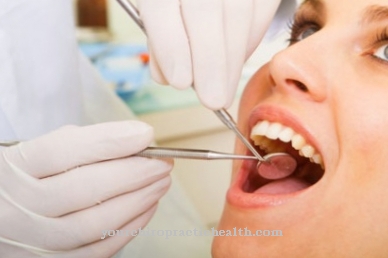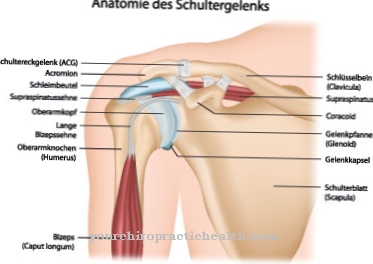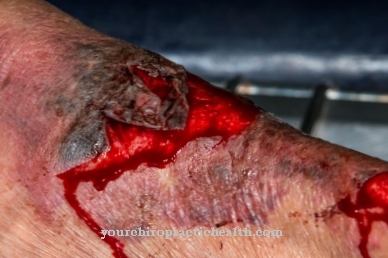As Lymphadenopathy is called a swelling of the lymph nodes. This symptom is considered an indication of various diseases.
What is lymphadenopathy?

© lom123 - stock.adobe.com
Under the name Lymphadenopathy among other things, non-specific lymph node diseases are summarized. Swelling of the lymph nodes takes place. Normally, the lymph nodes, which can be found almost everywhere in the human organism, do not exceed one centimeter in size, which means that they can hardly be felt.
If this is the case, however, it is referred to as lymphadenopathy or lymph node swelling. In most people, the swelling is caused by infection. Swollen lymph nodes usually show up as part of flu-like infections or fever and are considered harmless.
Occasionally, however, they also indicate serious illnesses that require medical clarification. These include measles, rubella, inflamed tonsils, malaria, syphilis, toxoplasmosis or AIDS. In addition, lymphadenopathy can occur in the context of benign or malignant tumors.The lymph node swelling either only shows up in certain parts of the body or all over the body, as is the case with lymph gland cancer, for example.
causes
The causes of lymphadenopathy are manifold. Mostly there are relatively harmless diseases such as a viral infection behind it, which can be a cold. But there are also specific viral infections that are responsible for the symptom.
These include Pfeiffer's glandular fever, rubella, measles, mumps, shingles, herpes, cytomegaly, Lassa fever or an HIV infection. Certain bacterial infections can also cause swelling of the lymph nodes, such as salmonellosis, tuberculosis or syphilis.
Other conceivable causes are diseases such as malaria, fungal infections, toxoplasmosis, rheumatic diseases such as systemic lupus erythematosus (butterfly lichen) or rheumatoid arthritis, metabolic diseases such as Niemann-Pick's disease or Gaucher disease, congenital immunodeficiency, sickle cell anemia or thalassemia.
The most serious triggers of lymphadenopathy include benign tumors and malignant cancers. The Kawasaki syndrome and sarcoid are classified as benign lymphomas. Malignant diseases are leukemia, lymph gland cancer such as non-Hodgkin lymphoma or Hodgkin's disease, and breast cancer, in which the lymph nodes in the armpit area swell. In some patients, lymphadenopathy also develops from the use of certain medicines.
Symptoms, ailments & signs
Lymphadenopathy is noticeable through enlargement of the lymph nodes, some of which can be felt. In some cases, the affected lymph nodes also respond with tenderness. In most people, however, there are lymph nodes that are free from pressure pain in the angle of the jaw. This area is located under the earlobe at the base of the lower jaw.
The same applies to the groin. If the skin can be moved easily and there is no pain or enlargement, there is no need to worry. However, if the lymph nodes cannot be moved against the skin and the surface or if they are interwoven as lymph node packages, this is an indication of a malignant disease.
If the lymphadenopathy is triggered by a general disease, the patient will also suffer from its symptoms. This can be a fever, sore throat, runny nose, rashes on the skin, night sweats, or weight loss.
Diagnosis & course of disease
If unexplained swellings in the lymph nodes do not subside after 14 days or if they increase in size, a doctor should be consulted. The same applies to swollen, immovable or painful lymph nodes. In addition to your family doctor, you can also consult an ear, nose and throat doctor or an internist.
The doctor first looks at the patient's medical history. He then does a physical examination, in which he palpates and taps the affected body regions. He prefers to deal with the swollen lymph nodes and controls their consistency, sensitivity to pain and mobility.
He also determines whether there is lymphadenopathy in other parts of the body. General signs of infection or inflammation are also important. Other examination methods include a blood test, a sonography (ultrasound examination) of the lymph nodes and the removal of a tissue sample (biopsy).
Diagnostic imaging procedures such as x-ray examinations, computed tomography (CT) and magnetic resonance imaging (MRI) also play a role. The course of lymphadenopathy depends on its triggering cause.
If the underlying disease is as harmless as a flu-like infection, the lymphadenopathy disappears as the infection subsides. However, if the cause is serious, such as tumor formation, the swollen lymph nodes will persist.
Complications
In most cases, patients suffer from pressure pain in the lymph nodes from lymphadenopathy. This pain can be very uncomfortable and thus significantly reduce the quality of life of those affected. Lymphadenopathy can lead to unpleasant symptoms, especially in the area of the jaw and mouth, and significantly limit the person's everyday life.
The skin may also be affected, so that it also hurts when you pull or move it. Lymphadenopathy can be a serious condition that definitely needs to be examined and treated by a doctor. Patients can suffer from a runny nose or a sore throat and often have rashes on the skin. There may also be weight loss or night sweats.
Treatment of lymphadenopathy is usually based on the causes of this complaint and aims to reduce symptoms. Most of the time, antibiotics are used. As a rule, complications do not arise, so that the symptoms can be combated well. The disease usually progresses positively and the life expectancy of the person affected is not reduced by the lymphadenopathy.
When should you go to the doctor?
Swelling of the lymph nodes does not necessarily need to be examined. Medical advice is required if the swelling persists for more than 14 days or even increases in size. Aching or non-displaceable lymph nodes are also to be presented to a doctor. Warning signs such as fever, rashes, or weight loss suggest that there is a serious cause. A doctor should be consulted if symptoms worsen or a serious underlying disease is suspected to be the cause.
For example, people who suffer from a bacterial, viral or rheumatic disease should call their doctor if the lymph nodes swell. Lymphadenopathy should also be evaluated by a doctor if it recurs. Those affected should consult their family doctor or an internist. The actual therapy is carried out by a lymphologist, often in conjunction with various specialists for the respective symptoms. Treatment is usually combined with several follow-up visits to make sure that the lymphatic system is healthy and that there are no other symptoms.
Treatment & Therapy
The way in which lymphadenopathy is treated depends on the individual trigger. In the case of local infections or inflammations such as a cold or sore throat, no special therapeutic measures are required because the lymph nodes swell after the disease has ended.
Antibiotics may be required in the case of bacterial infections. On the other hand, if there is a viral infection such as glandular fever or measles, the focus is on treating the symptoms. The doctor treats serious viral diseases such as AIDS (HIV) with antivirals. These have the property of preventing viruses from multiplying.
If the patient suffers from lymph gland cancer, he receives a combination of radiation therapy and chemotherapy. The patient himself has only a few options to take action against lymphadenopathy. He usually has to wait until the lymph node swelling subsides again.
You can find your medication here
➔ Medicines against swelling of the lymph nodesOutlook & forecast
The prognosis of lymphadenopathy depends on the causal disease. The swelling of the lymph nodes is not an independent health disorder. Rather, it is a symptom of an underlying disease that needs to be diagnosed and treated. In most cases there is an infection that can be treated well with today's medical options. In some of them, a decrease in symptoms can be observed after some time, even without medical care. This is linked to the general state of health of the person concerned and the use of self-help measures.
In principle, however, you should work with a doctor for a favorable prognosis. Lymphadenopathy alone is not enough to know which treatment steps are necessary. If there is a congenital disorder, lifelong therapy is often indicated. In addition, a chronic disease can be the cause of the lymph node swelling. A steady increase in health irregularities can be expected here. If the person concerned suffers from cancer, the course of the disease can be unfavorable, which can lead to premature death.
A comprehensive medical examination must take place before the prognosis is made so that an individual treatment plan can be worked out. Even in patients who have achieved freedom from symptoms, symptoms can regress in the course of life.
prevention
Preventing lymphadenopathy is difficult. Against triggering inflammation or infections such as a flu-like infection, simple preventive measures such as taking vitamins, changing showers, toughening up or lots of fresh air are possible. In some cases, tried and tested home remedies are also considered helpful. Regular cancer screening examinations are recommended for the early detection of tumor diseases.
Aftercare
In most cases, lymphadenopathy is associated with severe symptoms and complications that can significantly reduce the quality of life of the person affected. Therefore, the patient should consult a doctor at the first symptoms and signs of the disease so that there are no further complications and no further worsening of the symptoms.
Since the disease weakens the organism in many ways, those affected should avoid physical exertion as far as possible and take it easy. Depending on your condition, gentle exercise like yoga can help keep you moving as well Avoid damage caused by long periods of restraint and ensure elasticity.
If the symptoms are not treated, the disease can also cause irreversible damage to internal organs. In many cases, however, lymphadenopathy can be treated well if an early diagnosis is made. Then the life expectancy of the person affected is usually not reduced by the disease.
You can do that yourself
Overall, the possibilities for self-help with lymphadenopathy are limited. However, whether prevention is possible, which can be done on your own, depends on the cause of the lymph node swelling. Unfortunately, there are no ways to help yourself during the illness. If it is an infection, however, the lymphadenopathy usually heals on its own. If the swelling persists, however, a doctor should be consulted urgently in order to rule out a possibly serious illness.
For some diseases that can lead to lymphadenopathy, everyone can prevent lymphadenopathy themselves. This is especially true for infectious diseases that can be prevented by a strong immune system. This can be achieved through a healthy lifestyle with a balanced diet and exercise in the fresh air. In addition, alcohol, smoking and the abuse of drugs and medication should be avoided. Furthermore, care must be taken to avoid all possible ways of infection.
However, lymphadenopathy can be triggered by other causes besides infection. Prevention or self-help is then not always possible. This applies, among other things, to the underlying congenital or hereditary diseases. However, if environmental pollution such as dust or asbestos fibers is a possible cause of lymphadenopathy, everything should be done to rule out the causative factors. This can be guaranteed, among other things, by strict compliance with the relevant occupational safety measures.



.jpg)























